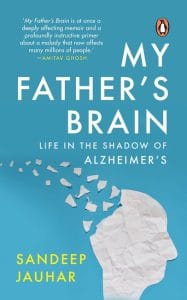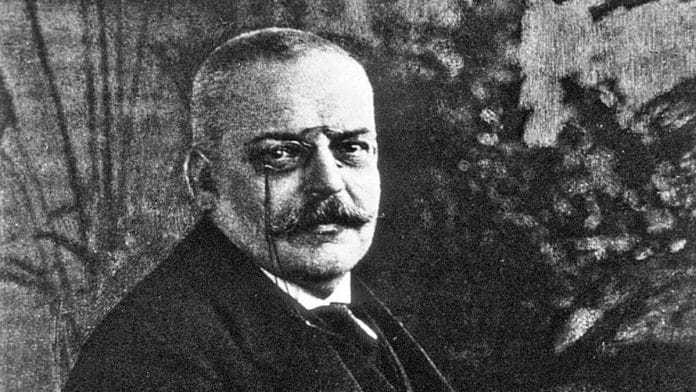By the end of the nineteenth century, age-related dementia was believed to be a consequence of reduced blood flow through hardened blood vessels that led to strokes. Neuropathologists commonly described cases of “vascular dementia” in elderly patients whose blood vessels were filled with fatty deposits. However, vascular disease did not explain all cases of dementia, particularly those arising in patients at a relatively young age. Notably, it did not explain what was ailing a fifty-year-old German woman named Auguste Deter, who in 1901 was admitted to Frankfurt’s Municipal Asylum for Epileptics and Lunatics, where she was treated by a brilliant psychiatrist named Alois Alzheimer.
Deter was happily married and raising a daughter when she began her descent into madness. In the beginning she had paranoid delusions that her husband of twenty-eight years, Carl, a railway clerk, was having affairs, but her condition soon progressed to amnesia and profound disorientation. She greeted friends as if they were first-time acquaintances. She forgot daily events as soon as they had occurred. Within several months, she was unable to care for herself, prompting her husband to admit her to Frankfurt’s “Castle of the Insane,” as it was called. “I have lost myself,” she told her doctors.
“In the institution, her behavior showed all the signs of complete helplessness,” Alzheimer wrote. “She is completely disoriented in time and space. Sometimes she says that she does not understand anything and that everything is strange to her. Sometimes she greets the attending physician like company and asks to be excused for not having completed the household chores. Sometimes she protests loudly that he intends to cut her, or she rebukes him vehemently with expressions which imply that she suspects him of dishonorable intentions.”
Though her gait and reflexes were normal, “her memory is seriously impaired,” Alzheimer wrote. “If objects are shown to her, she names them correctly, but almost immediately afterward, she has forgotten everything.” Her language skills had broken down, too. “When reading a test, she skips from line to line or reads by spelling the words individually, or by making them meaningless through her pronunciation. In writing, she repeats separate syllables many times, omits others, and quickly breaks down completely. In speaking, she uses gap- fills and a few paraphrased expressions (‘milk- pourer’ instead of cup). Sometimes it is obvious that she cannot go on.”
At the time, Alzheimer was working as a clinical psychiatrist. However, his true passion was neuropathology. As a college student in Berlin, he had become fascinated by the microscopic study of cells. When he returned to Lower Franconia in Bavaria, where he was born, to study medicine at the University of Würzburg, he learned cell staining techniques. After graduating magna cum laude in 1887— his doctoral thesis was on the wax-producing glands of the ear— he was hired at the Municipal Asylum in Frankfurt, where he met Franz Nissl, a neuroanatomist who had invented a special cell stain, the eponymous Nissl stain, still in use today.
The two men became friends, working with patients during the day and spending evenings together at the microscope. Noting his junior colleague’s interest in histology— the study of the microscopic structure of tissues— Nissl encouraged Alzheimer to pursue research alongside his clinical work. However, it was only after Alzheimer’s wife, Cecilie, the daughter of a wealthy banker, died shortly after giving birth to their third child, thus bequeathing him a large sum of money and making him financially independent, that he took Nissl’s advice and devoted himself to laboratory research. By the time his patient Deter died in 1906, Alzheimer had moved to the Royal Psychiatric Hospital in Munich, where he had taken a position as a neuropathologist in the laboratory of Emil Kraepelin, one of Europe’s leading psychiatrists. Nonetheless, before leaving Frankfurt he had requested that Deter’s medical records and brain be sent to him for study after her death. They arrived in the spring of 1906.
In examining Deter’s brain, Alzheimer first noticed significant atrophy. The organ was light in weight and the cerebral cortex thinner than normal for her age. Using newly developed staining techniques, he examined thin slices of the brain tissue under a microscope. He found two puzzling abnormalities. First, “scattered through the entire cortex, especially in the upper layers, [were multiple, tiny] foci that were caused by the deposition of a peculiar substance.”
These accumulations are now known as senile plaques (Alzheimer called them “buildup products”), and the peculiar substance within them— a brain protein that has undergone structural changes, becoming “sticky” and forming microscopic collections— is called beta- amyloid. Though pathologists had known about amyloid since at least the middle of the nineteenth century (accumulations of different types of it had been observed in many aging organs, including the kidney, heart, and liver), it was not until 1927 that it was identified, with polarized light, as the primary constituent of brain plaques.
The other abnormality that Alzheimer observed, using a special silver stain, was tangles of previously undescribed fibers inside brain cells. “In the interior of a cell that otherwise appeared normal, one or several fibrils stood out due to their extraordinary thickness and impregnability,” Alzheimer wrote. These fibrils, electron microscopy later showed, start off as normal structures for transporting nutrients inside neurons but become abnormal when a protein called “tau” misfolds, twisting the fibers into helical shapes, thus interfering with their function.
The fibrils “merged into dense bundles and gradually reached the surface of the cell,” Alzheimer wrote. “Finally, the nucleus and the cell itself disintegrate and only a tangle of fibrils indicates the place where a neuron was previously located.” Most people over the age of fifty have some such tangles in their brains. It is probably a phenomenon of aging and will not cause dementia in a normal lifespan. However, tangles in the presence of amyloid plaques are much denser and more destructive. And so it was with Auguste Deter’s brain. It had disintegrated, its cell bodies flaring into comet-like shapes that bulged with abnormal protein collections. Up to a third of the neurons in her cerebral cortex were affected.
Alzheimer’s observations intrigued Emil Kraepelin, his mentor and the most famous psychiatrist in Europe at the time. Kraepelin had long set out to prove that mental disorders originate in brain pathology, and Alzheimer’s results resonated with this core belief. He encouraged his protégé to present his findings to the wider scientific community, which Alzheimer first did on November 3, 1906, at a conference of German psychiatrists in Tübingen. However, his lecture, attended by some one hundred people, provoked little interest. (The subsequent lecture on compulsive masturbation seemed to hold more appeal.)
A few months later, Alzheimer published a paper in which he laid claim to a “distinctive disease process” in the brain. “Considering everything, it seems we are dealing here with a special illness,” he wrote. However, that paper also garnered little attention.
 This excerpt from Sandeep Jauhar’s ‘My Father’s Brain’ has been published with permission from Penguin Random House India.
This excerpt from Sandeep Jauhar’s ‘My Father’s Brain’ has been published with permission from Penguin Random House India.






